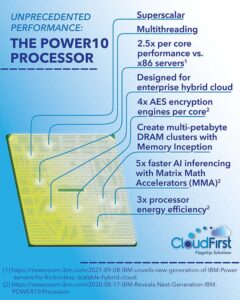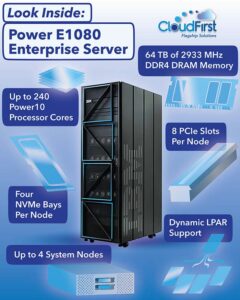Power10 is a huge upgrade from previous generations.
Are you facing issues running mission-critical apps on older IBM Power servers? Are you worried about cybersecurity?
The hardware you’re using may not even be supported anymore, and it’s hurting your team’s performance and profits.
Enter IBM Power10, the latest and greatest addition to the IBM Power Systems family. It delivers enhanced performance, scalability, and efficiency while also supporting hybrid cloud environments as well as AI training and inference. IBM’s design focuses on managing modern workloads while giving businesses opportunities to step into future endeavors with ease.
Burying your head in the sand with old tech won’t do you any favors. According to Kaspersky, “businesses with outdated technology are much more likely to have suffered a data breach (65%) than those that keep theirs updated (29%). This number increases to 77% in businesses that have suffered a breach and still have the C-suite using outdated technology.”
Those are alarming numbers; once you factor in the costs of admin and downtime, the expenses skyrocket. And that’s without even mentioning how legacy systems prevent you from accessing valuable technologies like app modernization and AI.
Let’s face it. It’s time for an upgrade.
This is what you get when you choose Power 10.
What’s new in IBM Power10

Power10 is the latest generation of IBM Power Systems server technology. It’s a great option for companies who want to continue running the IBM i or AIX systems they know and love while also reaping the benefits of new tech capabilities.
IBM Power10 brings many new features and improvements that make it a significant upgrade over its predecessors, Power9 and Power8. It has better performance overall, and its CPU performance per watt is much higher—up to 2.6x higher than Power9.
Another standout feature of Power10 is its improved security. With built-in end-to-end encryption, Power10 ensures that your data is protected at all times, whether at rest or in transit. Each Power 10 core contains four encryption engines, allowing for 2.5x faster AES encryption compared to the previous generation. This is a critical feature in today’s threatening landscape, where cyber attacks are becoming more and more sophisticated.
And these attacks aren’t just more complicated to deal with—they’re targeting small businesses that are often more vulnerable. Jack Koziol writes for Forbes, “Small- and medium-sized businesses (SMBs) are also victims of the most common cyber threats—and in some cases, more commonly as SMBs tend to be more vulnerable with fewer security measures in place. In fact, last year, 1-in-5 breach victims were SMBs.”
Secure-by-design hardware is a key element of a larger defense in depth strategy.
Another groundbreaking addition is the introduction of Matrix Math Accelerators (MMAs). This specialized silicon is an alternative to the pricey and scarce GPUs that power most machine learning workloads.
It’s built into the core for the sole purpose of speeding up and parallelizing linear algebra. Remember, most AI algorithms, such as deep learning, are fundamentally rooted in linear algebra. That’s why the graphics cards that process vectors for display on a screen are so suited to AI in the first place.
IBM also provides optimized libraries so that “AI applications running Python using PyTorch and TensorFlow can take advantage of MMA,” explains an IBM Developer blog by Charisse Lu, Peter Westerink, and Christine Ouyang. The authors go on to demonstrate how MMAs can accelerate inference for tasks like image detection, credit card fraud detection, and time series forecasting.
Technical advantages of Power10

The numbers speak for themselves. Power10 “provides 55% lower 3-year total cost of ownership (TCO) to run modern cloud-native applications, achieve 4.4x better per-core throughput, and collocate cloud-native apps with AIX, IBM i and Linux virtual machine-based apps and enterprise data to exploit low-latency API connections to business-critical data.”
This makes it ideal for running cloud-native tooling like Red Hat OpenShift, Kubernetes, and the software suites found in IBM Cloud Paks.
For example, the 2024 IBM Power Performance Report compares commercial processing workload (CPW) benchmark performance between various IBM Power models. The S914 (Power9) with four cores running at 2.3-2.8 GHz clocks in at 52,500 CPW. In contrast, the S1014 with the same number of cores boasts 3.0-3.9 GHz and 106,300 CPW. That more than doubles the amount of CPW you’ll get by making the switch.
IBM has also revamped memory capabilities, offering higher capacity and faster access times. This reduces the runtime for large workloads and opens the door to big data analytics. Power10 has introduced a new technology called Memory Inception, which enables systems to share each other’s memory to create multi-petabyte sized memory clusters.
Stranded or imbalanced memory is now a thing of the past, especially with Power10’s improved I/O performance.
On its own, a single Power E1080 Enterprise server comes equipped with 64 TB of 2933 MHz DDR4 DRAM memory. Combined with eight PCIe slots per node and four NVMe bays per node on a system that can contain between one and four nodes, this offers end users tons of options for adding low-latency storage and additional GPUs to accelerate ML training and inference.
As mentioned above, things get really interesting when we start clustering servers together. On a cloud infrastructure platform like CloudFirst, you’ll get instant access to fully configured clusters of the latest IBM Power Systems hardware. Start running even the largest HPC workloads without ever having to build or maintain your own data center.
Business advantages of Power 10
Why should business leaders care about these technical improvements?
Power10 offers a clear and compelling business case for upgrading from older systems. Better performance lets you do more with less, which lowers your costs and frees up your budget for other uses. We often see that businesses are able to lower their overall license count after an upgrade because they’re able to access just as much or more CPW on a smaller number of machines.
The new security features can help you avoid costly data breaches and comply with strict regulations, which is a major concern for industries that handle sensitive data.
Modernizing your apps and integrating AI and other next-gen solutions helps you stay competitive. An upgrade allows you to automate routine tasks and gain insights from predictive analytics. These insights can then improve the efficiency of the back office or even help you chart a strategy for anything from sales to marketing to product development.
These are not just technical enhancements; they are business enablers that pay dividends down the line.
What you can do with Power10 (that you can’t with 8 or 9)

With Power10, you’re not just getting an upgrade; you’re getting new capabilities that were simply not possible with Power9 or Power8.
The MMAs for AI workloads allow you to run complex machine learning models faster and more efficiently. MMAs are especially useful for model inferencing, meaning you can integrate AI into your core business applications, such as Db2 databases, and therefore operationalize AI at the point of data.
This can help improve a variety of processes in terms of automating routines like patch management on the system itself as well as generating business intelligence from the data itself. The end result is a real competitive advantage.
The enhanced security features mean you can operate with greater confidence, knowing that your data is protected against the latest threats and that you’re compliant with regulations like ISO 27001.
Simply put, Power10 takes everything you already love about IBM Power Systems and brings it into the here and now with comprehensive, modern tools.
The real-world effects of an IBM Power Systems upgrade
The benefits of upgrading your IBM Power Systems don’t just look good on paper. They can change how your business operates, spends, and allocates resources.
For example, let’s say a company wants to train their employees using AI. Their current IT infrastructure can’t handle the amount of data it needs, nor does it have the built-in capacity to run the AI models.
An upgrade to Power10 would improve training outcomes and simplify the onboarding process for new employees. Both can be significant time and money sinks, so having a more efficient way to handle them is an incredible asset for your bottom line.
This strategy is even more powerful when accessing IBM Power10 in the cloud. Sebastian Avila writes for Forbes: “To affordably upgrade legacy systems, smaller businesses should focus on regular software updates and cloud migration. This strategy prevents security risks from outdated technologies and reduces costs. By adapting existing code to newer versions and leveraging cloud efficiency, businesses can enhance productivity without starting over, ensuring a smoother, more cost-effective improvement process.”
IBM Power10: Filled with features that have your future in mind
IBM Power10 is more than new hardware.
It’s a complete solution for today’s business and IT challenges. Whether you’re a business leader looking to reduce costs and improve efficiency or a technical professional seeking a more secure and high-performance platform, Power10 offers compelling benefits that boost your bottom line.
Get instant access to the latest Power Systems hardware on our secure cloud. Request a quote today.

